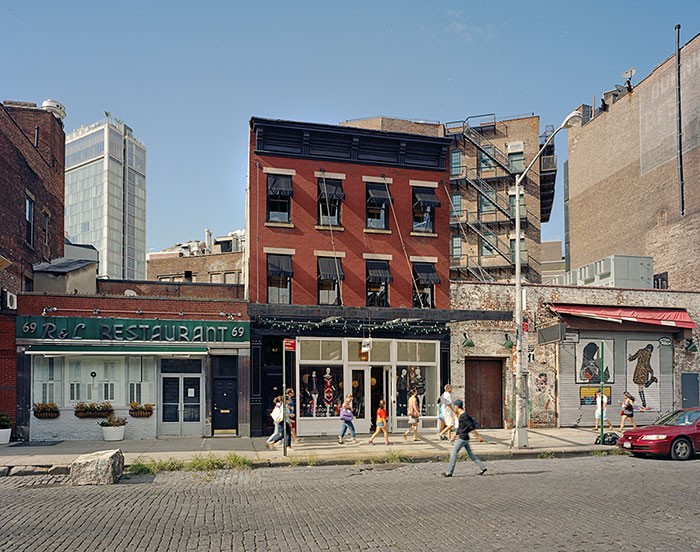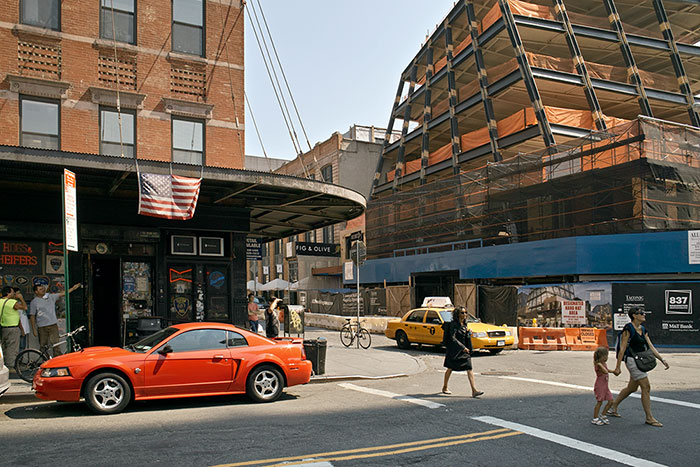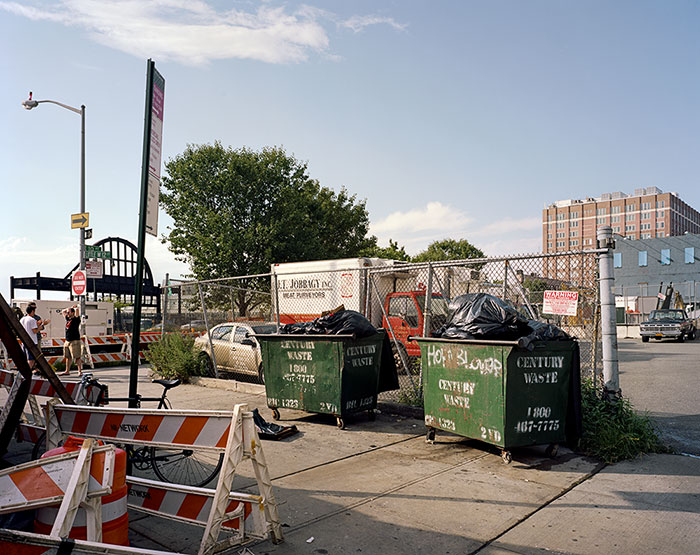
On the street with a print from a 1985 image. (digital) — © Brian Rose
Everyone thinks I should do it, so I am working on a series of before/after images of the Meatpacking District. I originally photographed the area in 1985, also venturing uptown into west Chelsea. I had completed the Lower East Side project — which I later came back to — and I had finished photographing the Financial District — with an NEA grant. I had also begun photographing various NYC parks, and later that year I would begin my travels along the Iron Curtain border across Europe. But for a week or so in late winter of 1985 I wandered around the west side of Manhattan and documented the profoundly empty streets, like a stage set with the actors on break. Eventually, as we all know, the people would come.
 Gansevoort Street 1985 (4×5 negative) — © Brian Rose
Gansevoort Street 1985 (4×5 negative) — © Brian Rose
 Gansevoort Street 2013 (4×5 negative) — © Brian Rose
Gansevoort Street 2013 (4×5 negative) — © Brian Rose
My experience with photographing New York, however, does not always follow the usual expectations about then and now. And with the Time and Space on the Lower East Side I deliberately wanted to challenge preconceived notions about what change actually looks like on the streets of the city.
New York, even the relatively glittering canyons of Manhattan, remains an often gritty place. The Meatpacking District has become a center of fashion and art, but like Soho before it, it continues to show its utilitarian roots, and is still dominated by late 19th and early 20th century architecture. The Gansevoort Market is still in business under the High Line housing a number of meat purveyors. In the view above of Gansevoort Street, one has to look twice to see the changes. Florent, the famous restaurant from ’80s is gone, and another restaurant has taken its place. The storefront of the small reddish building is now a boutique, but much of the block remains empty — as a Maserati rumbles along the cobblestones.
 Gansevoort Street 2013 (4×5 negative) — © Brian Rose
Gansevoort Street 2013 (4×5 negative) — © Brian Rose
As is often the case, “after” photographs can be less compelling than “befores.” The factors that led to the first image being made, are no longer present. These can be very subtle attributes, atmospheric, ineffable. So, part of my strategy in rephotographing the Meatpacking District is to look for new pictures, or variations on the originals. The image directly above was made a few minutes after repeating the 1985 picture. It is, perhaps, a better description of the block with the Standard Hotel looming in the background.
 Washington Street 1985 (4×5 negative) — © Brian Rose
Washington Street 1985 (4×5 negative) — © Brian Rose
 Washington Street 2013 (digital) — © Brian Rose
Washington Street 2013 (digital) — © Brian Rose
 Washington Street 1985 (4×5 negative) — © Brian Rose
Washington Street 1985 (4×5 negative) — © Brian Rose
 Washington Street 2013 (digital) — © Brian Rose
Washington Street 2013 (digital) — © Brian Rose
I am shooting the new photographs in 4×5 film using a similar camera and lens as in 1985, but then scanning the negatives and working up the images in Photoshop. Some of the images here were taken with my point-and-shoot, which I usually have with me while working with the big camera. As the film gets processed and the images completed, I will replace the digital snaps with the final 4×5 photos.
 Washington Street 1985 (4×5 film) — © Brian Rose
Washington Street 1985 (4×5 film) — © Brian Rose
 Washington Street 2013 (4×5 film) — © Brian Rose
Washington Street 2013 (4×5 film) — © Brian Rose
 Washington Street 1985 (4×5 film) — © Brian Rose
Washington Street 1985 (4×5 film) — © Brian Rose
 Washington Street 2013 (4×5 film) — © Brian Rose
Washington Street 2013 (4×5 film) — © Brian Rose
In a previous post, I wrote about this being the former location of the Mineshaft, an infamous men’s sex club closed at the height of the AIDS crisis just a few months after my photograph was taken in 1985. Now, other sybaritic delights beckon.
 West 14th Street 1985 (4×5 negative) — © Brian Rose
West 14th Street 1985 (4×5 negative) — © Brian Rose
 West 14th Street 2013 (4×5 negative) — © Brian Rose
West 14th Street 2013 (4×5 negative) — © Brian Rose
The images above are both 4x5s. I made several pictures with the 14th Street Apple store clearly visible on the right, but stepping a few feet forward better duplicated the original image.
 Hudson and 14th Street 1985 (4×5 film) — © Brian Rose
Hudson and 14th Street 1985 (4×5 film) — © Brian Rose
 Hudson and 14th Street 2013 (4×5 film) — © Brian Rose
Hudson and 14th Street 2013 (4×5 film) — © Brian Rose
 Little West 12th Street and West Street 1985 (4×5 film) — © Brian Rose
Little West 12th Street and West Street 1985 (4×5 film) — © Brian Rose
 Little West 12th Street and West Street 2013 (4×5 film) — © Brian Rose
Little West 12th Street and West Street 2013 (4×5 film) — © Brian Rose
 Pier 54 2013 (digital) — © Brian Rose
Pier 54 2013 (digital) — © Brian Rose
When I photographed the area in 1985, Pier 54 was an enclosed building as seen above. At present, only the steel structure of the facade remains. Occasionally the the otherwise empty pier is used for events. A small part of it is open to the public, and while I was there a couple of female skateboarders zoomed about while bicycles and joggers streamed along West Street.
Stay tuned for more pictures.
Wow, this is really cool.
I love the yellow street signs, especially on the Hudson and 14th Street picture. For someone who knows the city only with its modern green / brown street signs, that change alone makes Manhattan seem almost unrecognizable in these old pictures.
Thank you for taking the time to revisit the area. I feel honored to have worked in the city during the time your original photos were taken.
I’ve lived here all my life and watched this transformation. Very grateful that you’re doing this. Thank you. Your photos are so evocative. Both of then and now. I will look for more.
I use to work for a display company on 14th and I remember how in the summer, there would be pools of blood and OMG it would stink in the summer. Good times.
I am still ticked at myself that, in all the time I use to hang down there (for work and then Mother), that I never had the foresight to climb up onto the old elevated line. It is gorgeous now but, I bet I could have gotten into all kinds of mischief back then.
Thanks for this cool collection.
-d
Wonderful. I wish I could see them printed large.
Hoping to show big prints next July at Dillon Gallery on 25th Street.
These are great. Please let me know when you show at Dillon.
This is so incredible. Thank you so much for sharing!!!
Thanks for the great photos Brian. I grew up in the neighborI grew up in the neighborhood and went to school at Saint Bernard’s on West 13 Street as a kid. We use to ride our bikes in the meat market and then jamb on the brakes to slide on the animal fat that coated the streets and sidewalks. We even use to hold on to the meat hooks and run and slide down the racks that were outside of the meat wholesalers. We used to sneak up on the NY Central tracks all the time. Those were good times, I dare mention swimming off the piers or the barges on Gansvoort Street… they were not the best of days as I recall the eals. My Mother used to tell me that a young boy dove off a barge and got his head caught in a passing milk can, they later found him dead.. I never knew if the story was true of like the boy who lost his eye with the BB gun that I wanted back then. One thing that is for sure its that I enjoy the heck out of this site.. Kevin
THANKS!
Brian- As a life long fan of your work… please, I implore you, beg you, beseech you- no more shots of those super fugly, god awful toe thingies!!!
Give me a break!!! I’m 59 with knees ravaged by years of street basketball. But I’m still out there in the playground with my 14 year old son. And I’m still lugging around a 4×5 view camera. These “super fugly, god awful toe thingies” keep me in the game.
Hi Brian,
I don’t mind what you’re wearing. Just as long as you keep making, posting and hopefully publishing these photo’s.
I love them! The stories they tell.
Whoa- easy there big guy! I’m sure you’ve heard worse in any pick up game you choose before the ball even hits the rim. I know I have in any class I’ve ever taught where every square inch of you, your body, personality, history, etc is very much fair game. Was raggin’ on your shoes is all- too much real shit going down to take this serious…
Rag away, Stan. I’m not going to take my ball and go home.
Somewhat older than you, having been born in the Inwood section in Washington Heights, I also explored the “Wild West” starting in the mid 1960’s. It was empty during the day, as was what is now called Soho.
It’s interesting to me to see how much of the “after” changes are gentrification. The presence of shoppes selling high priced clothing, furniture along with the appearance Ferrari’s and Land Rovers show the basis on which the section has changed.
Also many years ago, the Daily News (or perhaps one of the other newspapers) had an occasional pair of photos marked “then and now”. Staffers, I presume, were assigned to do new photos from the point of view of available older images. The accompanying texts would many times list what had happened to the old structures. One that sticks in my mind is the old Madison Square Garden.
Very interesting. Some of these shots are such perfect matches you could use them in something like JuxtaposeJS
http://juxtapose.knightlab.com/